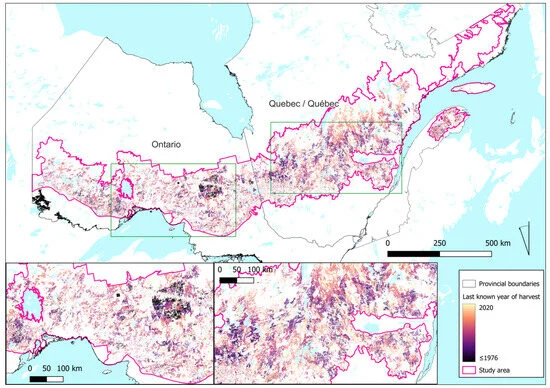Quebec and Ontario’s environmentally crucial boreal forests had a tough wildfire season in 2023. The provinces had 12.8 million and 1.1 million acres burn, respectively.
The 44 million acres burned by wildfires across Canada have been attributed mainly to abnormal drought and high temperatures, but a new study is pointing to another possible factor: the planting of millions of acres of immature trees after widespread logging. A recent study published by researchers at Australia’s Griffith University found more than 35 million acres of Canada’s forests have been lost to logging since 1976, including 20 million acres in Quebec and 14 million acres in Ontario.
The “loss” wasn’t caused by deforestation, which is “land that has been cleared of trees and permanently converted to another use” under Canada’s definition. Rather, the forest has been lost to forest degradation, or the conversion of naturally regenerating forest to plantations of planted trees.
“The Canadian Government claims that its forests have been managed according to the principles of sustainable forest management for many years,” the researchers said, “yet this notion of sustainability is tied mainly to maximizing wood production and ensuring the regeneration of commercially desirable tree species following logging,”

The decrease in the land area of older, more resilient forests across both Quebec and Ontario — and their subsequent replacement with immature trees — both lowered overall forest biodiversity and increased the prevalence of disturbances (wildfire, insect infestations, disease spread) over time.
“Logging has significantly increased the rate of disturbances in this region,” the report said. “This decrease in older forests when compared with historical natural conditions is accompanied by the resulting decline in structural attributes — such as large live and dead standing trees and coarse woody debris associated with older forests — which negatively affects biodiversity.”
The full study is online [HERE].
Quebec and Ontario’s environmentally crucial boreal forests had a tough wildfire season in 2023. The provinces had 12.8 million and 1.1 million acres burn, respectively.
The 44 million acres burned by wildfires across Canada have been attributed mainly to abnormal drought and high temperatures, but a new study is pointing to another possible factor: the planting of millions of acres of immature trees after widespread logging. A recent study published by researchers at Australia’s Griffith University found more than 35 million acres of Canada’s forests have been lost to logging since 1976, including 20 million acres in Quebec and 14 million acres in Ontario.

I’ve seen dozens of plantations go up in one burn period over the course of my career. People that think we can log our way out of this problem are as disillusioned as the other side that blames everything on climate change…There needs to be a healthy mix of prescribed fire, logging, mastication, and letting wild fires burn larger( big box) when the conditions are right. After wet springs and before the rains come in is the time to adjust our aggressive IA strategy at the higher elevations. Everything humans have done in the west the last 200 years has created the issue we are facing today from over logging, to the conversion of timber stands to grazing land, introducing non native species, the hydro mining during the gold rush, decimated the watersheds and riparian area that were natural buffers against large fires..Overdevelopment in the foothills and mountains…As a firefighter It pains me to say I’ve also been part of the problem the last 25 years, Every aggressive initial attack that I’ve been part of over my career has made the landscape less resilient not more…Beware of Politicians on the left and the right that try to simply this topic, until we put politics aside and take a hard honest look at the root cause of why we are where we are, the problem is not going to get better.
This isn’t a study that looked to assess fires role in boreal forest degradation. It’s looking at harvest impacts on Caribou range. There is, most likely, a clear relationship between even aged forest management and fire, that’s not what the researchers were evaluating.
I think you’re maybe blurring the points, Don, between what the study set out to do and what the study found and what the report says. While I agree with you that there “likely” is a relationship between even-aged stands and fire, I’m not sure you’ve clearly conveyed the purpose and process of the study, which says, “the Canadian boreal zone is dominated by coniferous trees … but large areas are also covered by shade-intolerant deciduous trees … either in pure stands or, more commonly, intermixed with conifers. The primary drivers of boreal ecosystem dynamics are wildfires, alongside the secondary drivers of insects, diseases, and their interactions. Natural boreal forests, therefore, are not only composed of young postfire stands but also include significant proportions of old-growth stands characterized by different structures and dynamics.”
Did you read the whole thing?